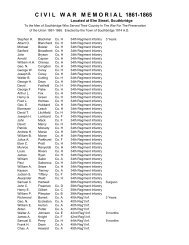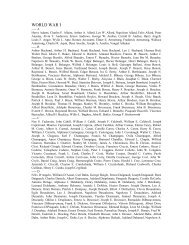Darryl Meister Technical Paper on Cyl Axis - Whitney Home Page
Darryl Meister Technical Paper on Cyl Axis - Whitney Home Page
Darryl Meister Technical Paper on Cyl Axis - Whitney Home Page
Create successful ePaper yourself
Turn your PDF publications into a flip-book with our unique Google optimized e-Paper software.
The circle of least c<strong>on</strong>fusi<strong>on</strong> is proporti<strong>on</strong>al to both the pupil size and power error. As the size of the circle<br />
increases, so do the diffusi<strong>on</strong> of visual informati<strong>on</strong> and the percepti<strong>on</strong> of blur by the wearer. Moreover, the<br />
circular patch of “blur” produced by the resultant cylinder power error at the circle of least c<strong>on</strong>fusi<strong>on</strong> is half the<br />
size of the circular patch of blur produced by a spherical error of equal magnitude. C<strong>on</strong>sequently, a given<br />
dioptric error in cylinder power produces half as much blur as an equal dioptric error in sphere power. 6<br />
For instance, recall that an error from the prescribed axis of 5° for a cylinder power of 2.00 D produces a<br />
residual astigmatic (cylinder power) error of 0.35 D. The blur produced by this cylinder error is comparable to the<br />
blur produced by a 0.35 / 2 = 0.175 D error in mean sphere power.<br />
At this point, it might be reas<strong>on</strong>able to ask why the ANSI Z80.1-1999 tolerance <strong>on</strong> cylinder power is comparable<br />
to the tolerance <strong>on</strong> sphere power if its effects up<strong>on</strong> visi<strong>on</strong> are less significant? There are several factors to<br />
c<strong>on</strong>sider. Firstly, power tolerances are generally based up<strong>on</strong> <strong>on</strong>e-half the smallest increment of measurement<br />
used during ocular refracti<strong>on</strong>. <strong>Cyl</strong>inder power is generally prescribed in 0.25-diopter increments, so a tolerance<br />
of roughly 0.25 / 2 = 0.125 D makes sense from a practical and metrological standpoint.<br />
Sec<strong>on</strong>dly, the tolerance <strong>on</strong> sphere power doesn’t actually apply to the mean sphere power (or spherical<br />
equivalent) of the prescripti<strong>on</strong>, but rather the power through <strong>on</strong>e principal meridian. For a cylinder power<br />
tolerance of 0.13 D and a sphere power tolerance of 0.12 D, the error in mean sphere power can reach up to<br />
0.13 / 2 + 0.12 = 0.185 D, or the sum of the sphere power tolerance and half the cylinder power tolerance.<br />
C<strong>on</strong>sequently, higher cylinder power tolerances effectively increase the sphere power tolerance.<br />
Lastly, the additive nature of the tolerances <strong>on</strong> cylinder must also be c<strong>on</strong>sidered, since errors in cylinder axis<br />
and cylinder power are both allowed. If the tolerance <strong>on</strong> cylinder axis allows up to 0.12 or 0.13 D of induced<br />
cylinder power, this will compound any error in the actual cylinder power, itself.<br />
Low <strong>Cyl</strong>inder Powers and Progressive Additi<strong>on</strong> Lenses<br />
One of the most problematic aspects of cylinder tolerances is the c<strong>on</strong>trol of cylinder axis in extremely low<br />
cylinder powers. In particular, progressive additi<strong>on</strong> lenses, which often have small amounts of cylinder power as<br />
a result of the surface astigmatism <strong>on</strong> the progressive surface, are susceptible to this problem. Laboratory<br />
technicians often find it difficult to achieve the desired prescripti<strong>on</strong> in low cylinder powers when processing<br />
progressive lenses.<br />
Due to the highly aspheric nature of progressive surfaces, the techniques used to manufacture the molds, and<br />
the variati<strong>on</strong>s produced during the manufacturing process, it is not unlikely for a progressive lens surface to<br />
have a small amount of unwanted surface astigmatism at the distance reference point—directly from the<br />
manufacturer. Progressive lens surfaces are highly aspheric and have a great deal of surface astigmatism, as a<br />
c<strong>on</strong>sequence of providing a progressive change in add power. This surface astigmatism results in unwanted<br />
cylinder power.<br />
Even though the near and distance reference points of a progressive lens may produce no unwanted cylinder<br />
power in the initial lens design, manufacturing factors—such as lens material shrinkage—can create variati<strong>on</strong>s<br />
in the surface powers of the lens blank. Moreover, the apertures of many focimeters can “pick up” some of the<br />
unwanted cylinder power surrounding the reference points of the lens. Finally, some modern progressive lenses<br />
may have a small amount of cylinder power intenti<strong>on</strong>ally engineered into lens design at the distance and/or near<br />
measurement points in order to compensate for the effects of lens tilt and the positi<strong>on</strong> of wear <strong>on</strong> the power of<br />
the lens as perceived by the actual wearer. This is referred to as as-worn optimizati<strong>on</strong>.<br />
Because of the difficulties inherent in the producti<strong>on</strong> and measurement of progressive lenses, the Internati<strong>on</strong>al<br />
Standards Organizati<strong>on</strong> has established looser surface power tolerances for progressive additi<strong>on</strong> lens blanks<br />
(ISO 10322-2). 7 ISO tolerances allow 0.09 D of unwanted surface astigmatism in the distance z<strong>on</strong>e of most<br />
progressive lens blanks, which is over two times what ISO tolerances allow for c<strong>on</strong>venti<strong>on</strong>al bifocals. The<br />
unwanted cylinder power produced by this surface astigmatism interacts with any prescribed cylinder power <strong>on</strong><br />
the back surface of the lens, resulting in a crossed cylinder effect, which can be computed using the<br />
mathematics described earlier (Equati<strong>on</strong>s 1 and 2).<br />
<strong>Cyl</strong>inder power <strong>on</strong> a lens surface, which has occurred either because of engineering, manufacturing, processing<br />
or measuring, will interact optically with any prescribed cylinder power. A c<strong>on</strong>sequence of this effect is a change<br />
in the axis of the prescribed cylinder power, particularly in weak cylinders. When <strong>on</strong>e cylinder power is<br />
c<strong>on</strong>siderably str<strong>on</strong>ger than the other, the resultant axis will shift very little from the axis of the str<strong>on</strong>ger cylinder.<br />
C<strong>on</strong>sequently, progressive lenses with a small amount of unwanted cylinder power in the distance z<strong>on</strong>e will<br />
generally have very little effect up<strong>on</strong> str<strong>on</strong>ger prescribed cylinder powers.<br />
<strong>Page</strong> 4





